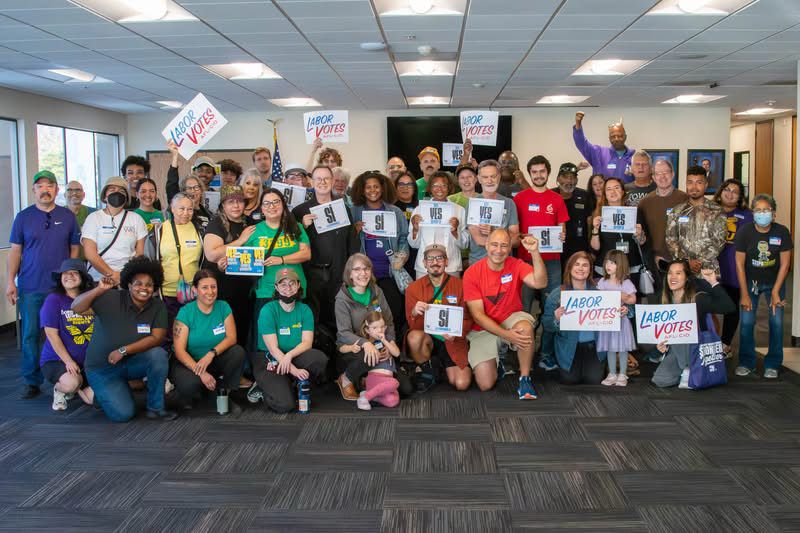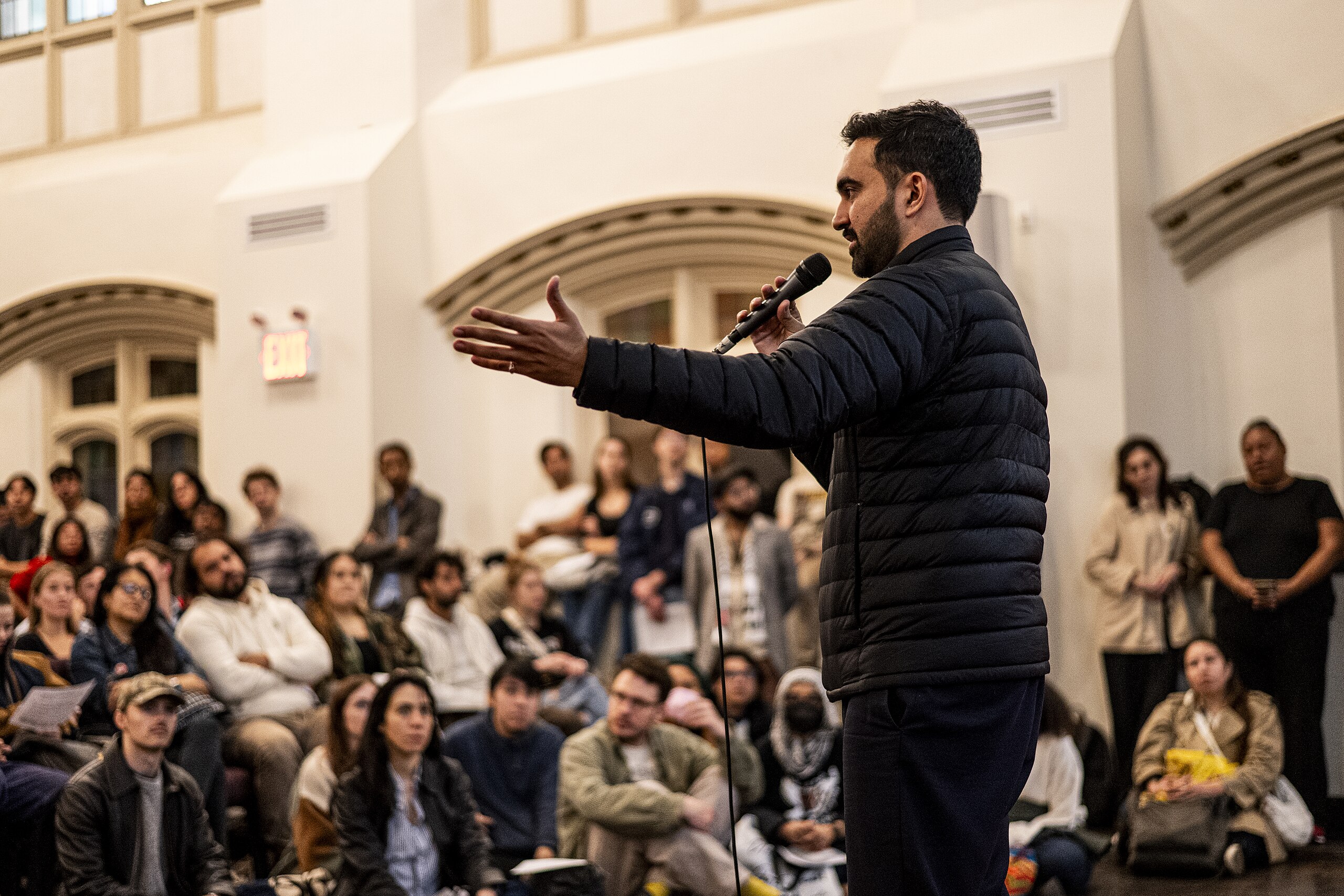As socialists work to build the local coalitions that will be needed to mount credible May Day actions on the way to 2028, a potential opportunity to connect with union workers has arisen in California: Proposition 50.
Prop. 50 is Gov. Gavin Newsom’s initiative to re-draw California’s congressional districts to boost Democratic wins in the 2026 midterm elections. (Prop 50 must go to the voters because it would bypass the popular and successful citizens’ redistricting commission that voters created in 2010, though it would leave the commission and its independent process intact for the 2032 election.) It is billed as a response to the actions by governors in red states – especially Texas – to skew the partisan composition of Congress by “rigging the election.”
California DSA, and several local DSA chapters, have endorsed Prop. 50. A major rationale for these endorsements is that California labor has made Prop. 50 a near-term priority. Labor councils across the state are holding canvasses and phone banks to turn out the vote. Some of these events have turned out dozens of union members.
If union members are in motion around Prop 50, it’s because so much is at stake for the labor movement and the broader working class. The Republican-controlled Congress has allowed Trump and Musk to fire federal workers en masse and withdraw recognition from their unions. The attack on federal workers signals a broader class war on all unions, as well as an attack on the public services and protections they provide to working class families. (This is why our solidarity with the Federal Unionists Network is so important.)
It’s a sound bet that a Democratic majority in Congress would block at least some of these wholesale rollbacks of decades-old protections.
At the same time, the Democrats’ response to the plight of the working class is contradictory and deeply inadequate. The heart of the problem is a class war against working people by billionaires. Billionaires, who poured money into Democrats’ campaigns in the last election, have now accomplished an autocratic takeover of the federal government, and are pushing it in an increasingly neo-fascist direction. The question, then, is how to most effectively fight back against this intensifying class war and Far Right agenda.
But the goal of Prop 50 is not to end the class war on workers or the oligarchy behind it, or to fight the Far Right. It is simply to win Democratic control of Congress through electoral rules changes. While the end of single-party rule will allow the Democratic Party to block some of the worst excesses of the oligarchy in power in Washington, there is no reason to believe that they will champion the working class over the billionaires if it succeeds.
In short, this is a struggle in which unions and their members are engaged – particularly those members who are looking for a way to fight back. On the other hand, the contradictions involved risk diverting attention from the real task at hand: building the connections between workers and socialists that can support an independent political struggle in the service of the pressing interests of the working class. In these circumstances, how should DSA respond?
The Democratic Party Cannot Mount the Fight
First and foremost, we must be clear-headed that the movement needed to topple this regime will not be led by the Democratic Party.
A Democratic Party that was ready to lead the opposition would have begun with a strategy to bring back the working class base on which it has long since given up. Instead, top Party leaders are loath even to back their own party’s nominee for Mayor of New York. Much less are they prepared to lead with their own affirmative agenda of improving wages and making housing, groceries, and transportation affordable to the working class.
One can forgive those who fall into wishful thinking about the Democrats as the bulwark of the resistance. In the face of the daily assaults on workers, immigrants, and trans people, of the attacks on the media, academy and public institutions, of the efforts to dismantle and privatize the federal government, we all wish an organized party fighting for working class interests was deployed on the field.
But wishful thinking is not our friend. The Party elites have decisively doubled down on their commitment to billionaire donors and corporate interests. The Democrats – here in California as much as anywhere – have not been a friend of workers where their interests come into conflict with those of the wealthy investor class. This year alone, for instance, the Party has been unwilling to use its control of the state legislature to buck the interests of real estate by extending the three-day eviction notice for nonpayment of rent to 14 days, or to impose a modest tax on the gross receipts of giant corporations to avert cuts to major Bay Area transit systems.
But more importantly, they have proven to be unwilling – and structurally unable – to mount a serious opposition to the Trump regime. As a recent scholarly analysis argues, the source of the Democratic Party’s power during the post-war decades – a mobilizable mass base of organized workers ready to fight their bosses – has been replaced in the neoliberal period by “a coalition [of policy NGOs that] had few points of intersection with one another, limited ties to large swaths of the electorate, and, perhaps most important, no access to sources of structural power.” As a result, the Democrats lack a mobilizable base to lead in a powerful opposition fight today:
Whereas labor unions no doubt face challenges associated with organizing and mobilizing mass memberships, policy clientele organizations not only lack labor’s structural power; they are often disarticulated from a mass base and have organizational incentives that promote risk aversion and the pursuit of narrower policy gains.
To be effective, opposition will instead have to be led by broad labor and community alliances – alliances which it is our job to help build. As lamentable as the Democrats’ weakness is at a time when organized opposition is critically needed, it is a positive development that some workers are pushing their unions to shift from a strategy of lobbying Democrats to one of organizing workers and community members to fight back.
One example is the Federal Unionists’ Network, which has reinvigorated previously sleepy federal unions and set an agenda of rank-and-file struggle against the billionaires attempting to dismantle and privatize humane federal services and protections, and to eliminate the union contracts of federal workers. The FUN’s organizing is particularly salient as they have shown how workplace struggle can – and today, must – be inseparable from political struggle.
When socialists engage with workers and unions campaigning to pass Prop 50, we can talk with them both about the threats of single party rule and about why there are no shortcuts when it comes to workers organizing independent vehicles of struggle. We can talk to them, in particular, about what happens after Election Day.
Probing Workers’ Interest In Independent Political Power
As part of California DSA’s campaign, it will host an educational webinar “in partnership with labor unions that articulates a democratic socialist analysis of our broken political system and seeks to strengthen our relationship with the labor movement.” That webinar, and other educational efforts – as well as the conversations we have in the field and in union halls with workers – should be directed at workers who are looking for a strategy to fight back. So what specifically should we be talking with them about?
To start, we should ask about the impacts the oligarchic and autocratic federal government is having on them, and how they think winning back Congress for the Democrats might help mitigate those impacts.
But we can also see which of these workers are open to a conversation about heightened expectations. We can first ask what they think about the Democrats’ strategy. Is there a strategy? Or is Prop 50 a tactic without any strategy behind it?
Second, what do they think about the tactic itself? After all, Prop 50 is essentially an effort to win seats in Congress by changing the rules, rather than by appealing to the working class politically. A real attempt to mobilize workers is unfolding right now in New York City, where Zohran Mamdani, though running as a Democrat, has built a mass base by focusing on making New York affordable to its working class residents. Have they heard about Mamdani’s campaign? What do they think about it? And why hasn’t the California Democratic Party – which right after Election Day 2024 said that it would be the party of affordability – committed to that path?
Third, aren’t there tactics that the Democratic Party could commit to that are not identical to the very MAGA tactics they attack? If Texas is rigging its election, isn’t California now committed to doing the same here? Even if we see the importance of such defensive tactics, shouldn’t we be demanding more and re-affirming our commitment to democracy?
Finally, does this all amount to a Democratic Party that is ready to lead the opposition? Or does the task of organizing that opposition fall to us? This is where we can hope to identify activated workers who are ready to join us in cohering May Day Committees and other local alliances in our communities.
Through political discussions like this as we engage with workers and voters about Prop 50, we can identify and form bonds with workers who are ready to take action to build the independent, worker-led resistance that these times call for, and that Democratic Party elites cannot supply.




